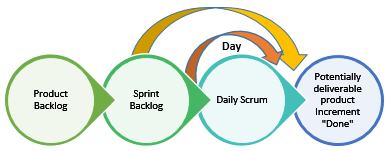The Heart of Scrum is a Sprint, is a preset interval during which it creates a usable, potentially deliverable product increment “Done or Finished”. Throughout the development there are consecutive Sprints of constant duration. In this post I wanted to detail five stages to consider for this tool is effective and successful in your projects Scrum.
In reality each Sprint can be considered a mini-project of no more than a month. Like projects, Sprints are used to achieve something. Each Sprint has a definition of what is to be built, a design and a flexible plan that will guide the construction of the plan, the work, and the resulting product.

We will talk about 5 stages: The Sprint planning meeting, the daily Scrums, the development work, the Sprint Review, and the Sprint Retrospective.
Sprint Planning Meeting
The work to be done in the Sprint is expected at the Sprint Planning Meeting. This plan is created with the collaboration of the whole Scrum Team.
The Sprint Planning Meeting is a variable-time event. For a one-month Sprint it’s eight hours long. For shorter Sprints, the event is proportionately shorter. For example, for a two-week Sprint, Sprint planning meetings are four hours long.
This meeting defines the functionality in the planned increment and how the Development Team will create this increase and the output of this work is to define the Goal of the Sprint.
The Sprint Planning meeting traditionally consists of two parts, each half of the Planning Meeting’s length of time responding to the following two questions:
- What will be delivered in the resulting increment of the next Sprint?
- How will the selected work be done?
Note that the goal of the Sprint can be a milestone in the broader objective of the product roadmap.
The Daily Scrum
It’s a 15 minute event, whose goal is for the development team to synchronize activities, and create a plan for the next 24 hours. This is done by inspection of the work from the last Daily Scrum, and the forecast of the work that can be done before the next. The Daily Scrum is carried out at the same time and place each day to reduce complexity.
The Development team uses the Daily Scrum to evaluate progress toward the Sprint goal and evaluate the trend of progress in completing the work in the Sprint Backlog. Every Day, the development team should be able to explain to the product owner and Scrum Master how they will work together as a self-organized team to achieve the goal and create the expected increase in the rest of the Sprint.
An added benefit is that daily Scrums improve communications, eliminate other meetings, identify and eliminate developmental obstacles, highlight and promote rapid decision-making, and improve the level of knowledge of the team project of development. This is a key inspection and adaptation meeting.
Development Work during the Sprint
When the Sprint is underway, we must ensure that:
- No changes affecting the goal of the Sprint are made;
- Quality objectives are Not diminished, and
- The Scope may be clarified and re-negotiated between the product owner and the Development Team as they are being learned.
When a Sprint is too long, the definition of what is being built can change, it can increase complexity and may increase the risk. Sprints allow predictability by ensuring inspection and adaptation of progress toward a goal of at least every calendar month.
Sprint Review
It is carried out at the end of the Sprint, to inspect the increment and adapt, if necessary, the Product Backlog. The Scrum Team and stakeholders collaborate during the review of what was done in the Sprint. Based on that and any changes in the Product Backlog during Sprint, attendees work on upcoming things that could be done. This is an informal meeting, and the presentation of the increase is aimed at getting feedback and encouraging collaboration.
The Sprint Review includes the following items:
- Attendees are the Scrum Team and key stakeholders invited by the Product Owner;
- The Product owner identifies what has been “done” and what has not been “done”;
- The Development team discusses what went well during the Sprint, what problems there were and how they were resolved;
- The Development team demonstrates the work that has been “done” and answers questions about the Increase;
- The Product owner analyzes the current status of the Backlog product, and estimates completion dates based on progress to date, and,
- The Entire group collaborates on what to do next, so the Sprint review offers valuable input to subsequent Sprint planning meetings.
- A review Is made of how the market or potential use of the product could have changed what is most valuable to do next; and
- Review of timeline, budget, potential capabilities and market for next planned product delivery.
The result of the Sprint review is a revised Product Backlog that defines the items of the Product Backlog of greater value or probable for the following Sprint. The Product Backlog can also be adjusted in general to meet the new opportunities.
Sprint Retrospective
It’s an opportunity for the Scrum Team to inspect themselves and create an upgrade plan to run during the next sprint. The purpose of the Sprint is:
- Review how the last Sprint was in terms of people, relationships, processes and tools;
- Identify and order The main issues that came out well and the potential improvements, and
- Create a plan to implement improvements regarding how the Scrum Team does their job.
